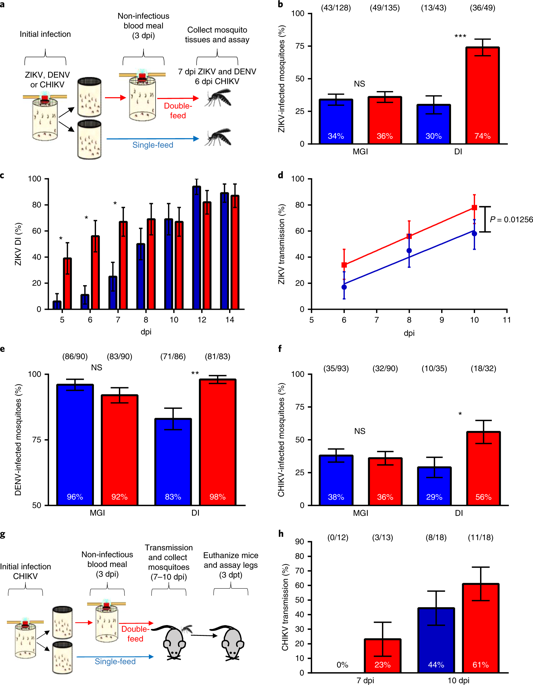当前位置:
X-MOL 学术
›
Nat. Microbiol.
›
论文详情
Our official English website, www.x-mol.net, welcomes your
feedback! (Note: you will need to create a separate account there.)
Successive blood meals enhance virus dissemination within mosquitoes and increase transmission potential.
Nature Microbiology ( IF 20.5 ) Pub Date : 2019-12-09 , DOI: 10.1038/s41564-019-0619-y Philip M Armstrong 1, 2 , Hanna Y Ehrlich 2 , Tereza Magalhaes 3 , Megan R Miller 3 , Patrick J Conway 1, 4 , Angela Bransfield 1 , Michael J Misencik 1 , Andrea Gloria-Soria 1 , Joshua L Warren 5 , Theodore G Andreadis 1, 2 , John J Shepard 1 , Brian D Foy 3 , Virginia E Pitzer 2 , Doug E Brackney 1, 2
Nature Microbiology ( IF 20.5 ) Pub Date : 2019-12-09 , DOI: 10.1038/s41564-019-0619-y Philip M Armstrong 1, 2 , Hanna Y Ehrlich 2 , Tereza Magalhaes 3 , Megan R Miller 3 , Patrick J Conway 1, 4 , Angela Bransfield 1 , Michael J Misencik 1 , Andrea Gloria-Soria 1 , Joshua L Warren 5 , Theodore G Andreadis 1, 2 , John J Shepard 1 , Brian D Foy 3 , Virginia E Pitzer 2 , Doug E Brackney 1, 2
Affiliation

|
The recent Zika virus (ZIKV) and chikungunya virus epidemics highlight the explosive nature of arthropod-borne viruses (arboviruses) transmitted by Aedes spp. mosquitoes1,2. Vector competence and the extrinsic incubation period (EIP) are two key entomological parameters used to assess the public health risk posed by arboviruses3. These are typically measured empirically by offering mosquitoes an infectious blood meal and temporally sampling mosquitoes to determine the infection and transmission status. This approach has been used for the better part of a century; however, it does not accurately capture the biology and behaviour of many mosquito vectors that refeed frequently (every 2-3 d)4. Here, we demonstrate that acquisition of a second non-infectious blood meal significantly shortens the EIP of ZIKV-infected Aedes aegypti by enhancing virus dissemination from the mosquito midgut. Similarly, a second blood meal increases the competence of this species for dengue virus and chikungunya virus as well as Aedes albopictus for ZIKV, suggesting that this phenomenon may be common among other virus-vector pairings and that A. albopictus might be a more important vector than once thought. Blood-meal-induced microperforations in the virus-impenetrable basal lamina that surrounds the midgut provide a mechanism for enhanced virus escape. Modelling of these findings reveals that a shortened EIP would result in a significant increase in the basic reproductive number, R0, estimated from experimental data. This helps to explain how A. aegypti can sustain explosive epidemics such as ZIKV despite relatively poor vector competence in single-feed laboratory trials. Together, these data demonstrate a direct and unrecognized link between mosquito feeding behaviour, EIP and vector competence.
中文翻译:

连续进食血粉可增强病毒在蚊子中的传播并增加传播潜力。
最近的寨卡病毒(ZIKV)和基孔肯雅病毒流行病凸显了伊蚊属(Aedes spp)传播的节肢动物传播的病毒(虫媒病毒)的爆炸性。蚊子1,2。媒介能力和外在潜伏期(EIP)是用于评估虫媒病毒造成的公共健康风险的两个关键昆虫学参数。这些通常通过为蚊子提供传染性血粉并在时间上对蚊子取样以确定感染和传播状况来凭经验进行测量。这种方法已经使用了一个世纪的大部分时间。但是,它不能准确地捕获许多频繁(每2-3天)喂食的蚊子的生物学特性和行为4。这里,我们证明,通过增强从蚊子中肠的病毒传播,第二次非传染性血粉的获取显着缩短了ZIKV感染的埃及伊蚊的EIP。同样,第二次进食血粉会增加该物种对登革热病毒和基孔肯雅病毒以及白纹伊蚊对ZIKV的竞争能力,这表明这种现象在其他病毒-载体配对中可能很常见,而白纹伊蚊可能是更重要的载体比以前想像的要多。围绕中肠的不可穿透病毒的基底层中的血粉诱导的微穿孔为增强病毒逃逸提供了一种机制。对这些发现进行建模后发现,缩短EIP会导致根据实验数据估算的基本生殖数R0的显着增加。这有助于解释A。尽管在单饲料实验室试验中病媒能力相对较差,但埃及伊蚊仍可维持ZIKV等爆炸性流行病。总之,这些数据证明了蚊子摄食行为,EIP和媒介能力之间的直接和不可识别的联系。
更新日期:2019-12-11
中文翻译:

连续进食血粉可增强病毒在蚊子中的传播并增加传播潜力。
最近的寨卡病毒(ZIKV)和基孔肯雅病毒流行病凸显了伊蚊属(Aedes spp)传播的节肢动物传播的病毒(虫媒病毒)的爆炸性。蚊子1,2。媒介能力和外在潜伏期(EIP)是用于评估虫媒病毒造成的公共健康风险的两个关键昆虫学参数。这些通常通过为蚊子提供传染性血粉并在时间上对蚊子取样以确定感染和传播状况来凭经验进行测量。这种方法已经使用了一个世纪的大部分时间。但是,它不能准确地捕获许多频繁(每2-3天)喂食的蚊子的生物学特性和行为4。这里,我们证明,通过增强从蚊子中肠的病毒传播,第二次非传染性血粉的获取显着缩短了ZIKV感染的埃及伊蚊的EIP。同样,第二次进食血粉会增加该物种对登革热病毒和基孔肯雅病毒以及白纹伊蚊对ZIKV的竞争能力,这表明这种现象在其他病毒-载体配对中可能很常见,而白纹伊蚊可能是更重要的载体比以前想像的要多。围绕中肠的不可穿透病毒的基底层中的血粉诱导的微穿孔为增强病毒逃逸提供了一种机制。对这些发现进行建模后发现,缩短EIP会导致根据实验数据估算的基本生殖数R0的显着增加。这有助于解释A。尽管在单饲料实验室试验中病媒能力相对较差,但埃及伊蚊仍可维持ZIKV等爆炸性流行病。总之,这些数据证明了蚊子摄食行为,EIP和媒介能力之间的直接和不可识别的联系。











































 京公网安备 11010802027423号
京公网安备 11010802027423号